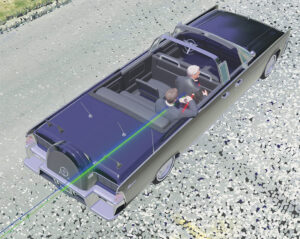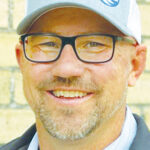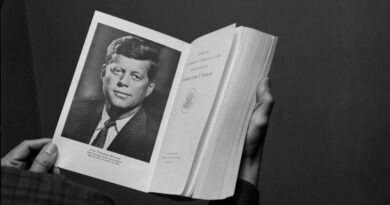Evidence to the contrary: Forensics firm adds to storied history of JFK assassination
Phil Castle, The Business Times
Nearly 60 years after that fateful Friday afternoon in Dallas, Stanley Stoll believes his company has produced new information about the assassination of President John F. Kennedy.

“The case is ongoing, but evidence strongly suggests there is more to the story in this historic event,” says Stoll, chief executive officer and principal engineer of Knott Laboratory, a forensic engineering and visualization company.
The commission assembled to investigate the assassination found Lee Harvey Oswald acted alone in firing three shots that killed Kennedy and wounded Texas Gov. John Connally.
Detailing his company’s research in an interview with the Business Times, Stoll says new evidence suggests the trajectory of one of the shots was different from the other two. He offers no opinions about the multitude of theories that have proliferated since 1963, but focuses instead on what he says is the science. “Modern science refutes the Warren Commission’s findings.”
Stoll works from an office in Grand Junction in overseeing a company that’s analyzed some of the most notorious tragedies in history. That includes the car accident that killed Princess Diana, the crash of an Air France Airbus and collapse of two walkways in a Kansas City hotel.
Stoll considers the JFK assassination the “case of the century,” and the analysis an important addition to the company’s portfolio of high-profile work.
John Orr, a former U.S. Department of Justice attorney who’s long researched the assassination, hired Knott Laboratory to conduct an investigation to corroborate or contradict his theories, including conjecture a fourth shot was fired from another location that would indicate a second gunman and wider conspiracy.
Combining high-definition laser scans with photographs, films and other evidence, Knott Laboratory created what Stoll terms a “digital twin” of Dealey Plaza in downtown Dallas with the exact location of the presidential limousine at the moment the shots were fired.
With the ability to accurately measure distances and angles, the company tested bullet trajectories from the sixth floor of the Texas School Book Depository, where Oswald was suspected of firing three shots. According to what became known as the single-bullet theory, one shot struck Kennedy in the back, exited his neck, entered Connally in the right armpit, exited his chest, went through his right wrist and finally embedded in his left thigh.
“The shooting position, bullet exit point on President Kennedy and entry point on Gov. Connally should all be reasonably in line,” Stoll says. “When drawing this line from the sixth-floor perch of the Texas Book Depository to the positions of the two men and their entry-exit points, we found a significant angle difference.”

For a single shot to go through JFK and Connally as detailed in the Warren Commission report, the governor would have had to been sitting 6 inches to 10 inches closer to the interior of the limousine, Stoll says. Photographs indicate that wasn’t the case.
Stoll plans to make the findings available on the company’s website in time for the 60th anniversary of the assassination on Nov. 22 and what he expects will be renewed interest in the event. He also plans to present the findings as one of the keynote speakers at a public safety and forensics conference scheduled for March in England.
Knott Laboratory is headquartered in Centennial. In addition to Grand Junction, the firm also operates offices in Colorado Springs and Fort Collins as well as locations in Atlanta and Phoenix. The firm employs a staff of 50, four of them in Grand Junction.
While the firm offers a range of services, most of them involve accident reconstruction and existing infrastructure. The firm analyzes and reconstructs a variety of accidents — everything from car crashes to workplace injuries to shootings. The firm also analyzes existing structures, whether that’s investigating failures, assessing current conditions or identifying potential problems.
Stoll grew up in Montrose and served in the Army. He earned bachelor’s and master’s degrees in civil engineering from the University of Louisville.
He joined Knott Laboratory in 2010 as a structural engineer and moved to Grand Junction in 2013 to work at what was at that time the first satellite operation for the company. In early 2020, he joined with Mike Lowe to purchase Knott Laboratory. Lowe serves as president.
Stoll says Colorado staff handled a lot of the research and analysis into the JFK assassination.
Stoll says he twice went to Dallas for laser scanning used to construct a digital version of Dealey Plaza.
The 36 laser scans generated a digital cloud with a total of 851 million data points about the plaza and surrounding buildings. Those points can be used to measure distances with an accuracy of within millimeters, he says.
Knott Laboratory combined that information with photographs and other evidence from the assassination, including the 8-millimeter home movie taken by Abraham Zabruder.
Using photogrammetry, a process of measuring and interpreting photographic images, as well as technique called match moving, the company was able to precisely place the presidential limousine, Kennedy and Connally into a digital recreation of the scene.
Knott Laboratory could then develop bullet trajectories between Oswald’s rifle on the sixth floor of the Texas School Book Depository and limousine passing below, Stoll says. “Our team tested bullet trajectories using the two frames of the Zabruder film where the first shots occurred and the known entry and exit points of Kennedy and Connally.”
That’s when the difference in angles was detected.
The crucial part of the analysis of the JFK assassination — as well as other investigations in which Knott Laboratory is involved — is combining accurate digital recreations with photographic and video analysis, Stoll says.
The information not only helps in establishing the facts of the case, but also creating visualizations to present that information.
The company is often hired to determine cause and fault and then present its findings in civil and criminal trials.
Those findings are based on the scientific method and proving or disproving hypotheses, Stoll says. “The culture of the company is based on scientific accuracy.”
He also credits collaboration among the engineers, accident reconstructors, visualization experts and others who work for the company. “The power of teamwork is truly incredible.”
Knott Laboratory has developed a reputation over its more than 40 years for offering what Stoll says is the pinnacle of forensic science. The company continues to grow in offering a range of services.
For now, Stoll says he’s excited about the latest high-profile investigation for the company and findings that could change history. “It’s big information.”
For more about Knott Laboratory and its investigation into the assassination of President John F. Kennedy, log on to the website at https://knottlab.com.


